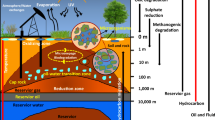Abstract
Two areas of Chesapeake Bay, Colgate Creek in Baltimore Harbor and Eastern Bay, are presently under study, with routine sampling of water and sediment for petroleum-degrading microorganisms (bacteria, yeasts, and fungi) by direct plating and enrichment culture. Selected physical and chemical parameters are recorded for each sampling site, and water and sediment samples are extracted for hydrocarbons. Numbers of petroleum-degrading microorganisms enumerated by direct plating were found to correlate with the concentration of benzene-extractable material and were higher for the Colgate Creek than for the Eastern Bay site. Petroleum-degrading microorganisms were isolated from water and sediment samples at environmental temperatures of 0°, 5°, and 10°C.
A salts medium supplemented with nitrate and phosphate was used to provide optimum conditions for petroleum degradation, whereas Chesapeake Bay water was used to simulate natural environmental conditions. Use of a model petroleum permitted quantitative measurement of utilization of individual hydrocarbons ranging in complexity from simple alkanes to polynuclear aromatic hydrocarbons. Higher growth yields and maximum hydrocarbon degradation was observed for microorganisms in the salts medium at 0°, 5°, and 10°C, although significant quantities of hydrocarbons were utilized in some samples grown in a medium for which Chesapeake Bay water was the diluent. Bacterial hydrocarbon degradation accounted for most of the model petroleum utilization at 0° and 5°C. However, oscillations of bacterial populations, with significant growth of yeasts, was observed at 10°C. Photomicroscopy and scanning electron microscopy revealed aggregates of bacteria, yeasts, and fungi associated with oil globules. From preliminary identification and classification of the hydrocarbon-utilizing bacteria, members of the generaVibrio, Aeromonas, Pseudomonas, andAcinetobacter were present in the enrichment cultures. From results of this study, it is concluded that utilization of model petroleum at low temperatures is a function of the types and numbers of microorganisms present in an original inoculum taken from the natural environment.
Similar content being viewed by others
References
Atlas, R. M., and Bartha, R. 1972. Biodegradation of petroleum in seawater at low temperature.Can. J. Microbiol. 18: 1851–1855.
Atlas, R. M., and Bartha, R. 1972. Degradation and mineralization of petroleum in seawater: Limitation by nitrogen and phosphorous.Biotechnol. Bioeng. 14: 309–318.
Cofone, L., Jr., Walker, J. D., and Cooney, J. J. 1973. Utilization of hydrocarbons byCladosporium resinae.J. Gen. Microbiol. 76: 243–246.
Colwell, R. R. 1970. Polyphasic taxonomy of the genusVibrio: Numerical taxonomy ofVibrio cholerae, Vibrio parahaemolyticus and realtedVibrio species.J. Bacteriol. 104: 410–433.
Colwell, R. R., Walker, J. D., and Nelson, Jr., J. D. 1973. Microbial ecology and the problem of petroleum degradation in Chesapeake Bay.In: The Microbial Degradation of Oil Pollutants. D. G. Ahearn and S. P. Meyers, editors. Publication No. LSU-SG-73-01, Center for Wetland Resources, Louisiana State University, Baton Rouge, La. pp. 185–197.
Lovelace, T. E., Tubiash, H., and Colwell, R. R., 1968. Quantitative and qualitative commensal bacterial flora ofCrassotrea virginica in Chesapeake Bay.Proc. Nat'l. Shellfish Assoc.,58: 82–87.
Massmann, W. H. 1971. The significance of an estuary on the biology of aquatic organisms of the middle Atlantic region.In: A Symposium on the Biological Significance of Estuaries. Sport Fishing Institute, Washington, D. C. pp. 96–109.
Niskin, S. J. 1962. A water sampler for microbiological studies.Deep-Sea Res.,9: 501–503.
Schubel, J. R. 1972. The physical and chemical conditions of the Chesapeake Bay.J. Wash. Acad. Sci. 62: 56–87.
Sisler, F. D., and ZoBell, C. E. 1947. Microbial utilization of carcinogenic hydrocarbons.Science 106: 521–522.
Traxler, R. W. 1973. Bacterial degradation of petroleum materials in low temperature marine environments.In: The Microbial Degradation of Oil Pollutants. D. G. Ahearn and S. P. Meyers, editors. Publication No. LSU-SG-73-01, Center for Wetland Resources, Louisiana State University, Baton Rouge, La. pp. 163–170.
Walker, J. D., and Colwell, R. R. 1973. Microbial ecology of petroleum-utilization in Chesapeake Bay.In: API/EPA/USCG Conference on Prevention and Control of Oil Spills. American Petroleum Institute, Washington, D. C. pp. 685–690.
Walker, J. D., and Colwell, R. R. 1973. Mercury resistant bacteria and petroleum degradation.Appl. Microbiol.,27: 285–287.
Walker, J. D., Cofone, Jr., L., and Cooney, J. J. 1973. Microbial petroleum degradation: The role ofCladosporium resinae.In: API/EPA/USCG Conference on Prevention and Control of Oil Spills. American Petroleum Institute, Washington, D. C. pp. 685–691.
Walker, J. D., and Cooney, J. J. 1973. Pathway ofn-alkane oxidation inCladosporium resinae.J. Bacteriol.,115: 635–639.
Walker, J. D., and Cooney, J. J. 1973. Oxidation ofn-alkanes byCladosporium resinae.Can. J. Microbiol. 19: 1325–1330.
ZoBell, C. E. 1969. Microbial modification of crude oil in the sea.In: API/FWPCA Conference on Prevention and Control of Oil Spills. American Petroleum Institute, Washington, D. C. pp. 317–326.
ZoBell, C. E. 1973. Bacterial degradation of mineral oils at low temperatures.In: The Microbial Degradation of Oil Pollutants. D. G. Ahearn and S. P. Meyers, editors. Publication No. LSU-SG-73-01. Center for Wetland Resources, Louisiana State University, Baton Rouge, La. pp. 153–161.
Author information
Authors and Affiliations
Rights and permissions
About this article
Cite this article
Walker, J.D., Colwell, R.R. Microbial degradation of model petroleum at low temperatures. Microb Ecol 1, 63–95 (1974). https://doi.org/10.1007/BF02512380
Issue Date:
DOI: https://doi.org/10.1007/BF02512380



